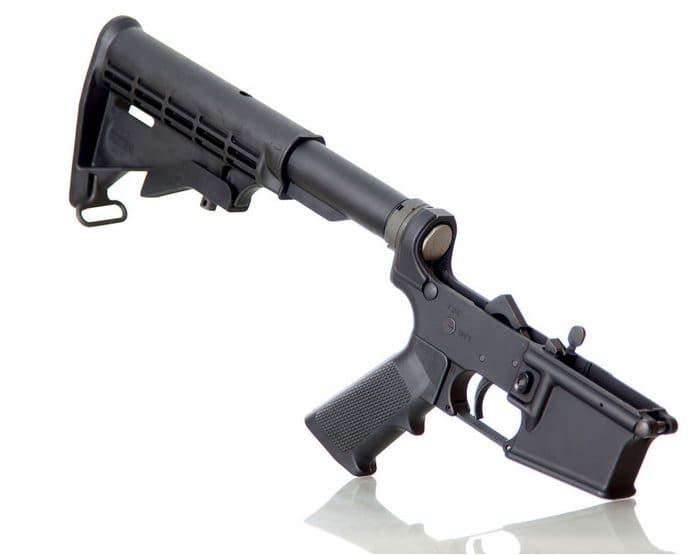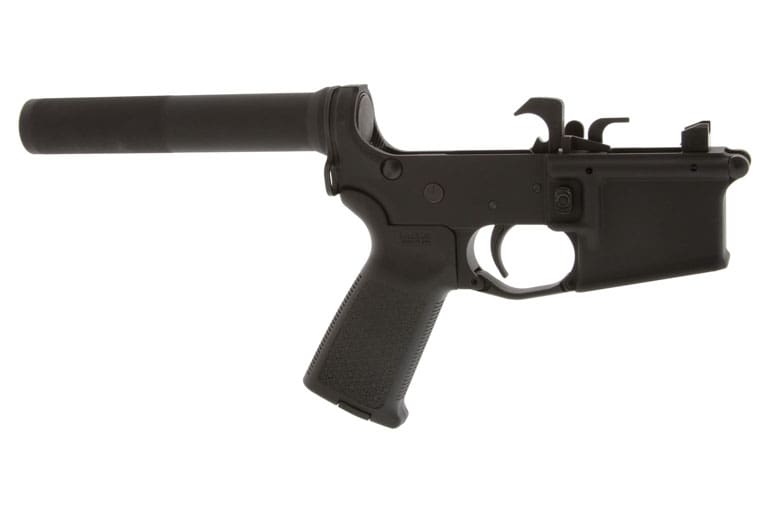By AT3 Tactical
Understanding the difference between mil-spec and commercial AR-15 buffer tubes
This is one of the most common questions we’re asked, and for good reason. If you’re planning to build your own AR-15 or upgrade your AR-15 stock, it’s critical to understand the subtle differences between mil-spec and commercial AR-15 buffer tubes, two very similar standards.
Buffers, Tubes, Stocks, and Springs: Definitions
The AR-15 buffer tube (also known as the receiver extension), is the metal protrusion that’s attached to the rifle’s lower receiver and sticks out of the back. It serves two functions: it houses the recoil buffer mechanism and is the attachment point for the rifle’s buttstock.

The reason it’s referred to as a “buffer tube” is because inside the tube is a large spring (called the action spring), and a weighted part known as the “recoil buffer.”

More info: When the rifle is “cocked” using the charging handle, the action spring is what makes the bolt slide back forward when the bolt is released. Also, after a round is fired, the action spring is what pushes the bolt back forward into battery and chambers the next round.
The recoil buffer sits inside the spring, and its weight provides a “buffer” against the recoil forces. By changing the weight of the buffer, you can change the characteristics of how the rifle cycles.
The difference between mil-spec and commercial buffer Tubes
Now that you know what’s going on inside the tube, let’s examine the difference in types.
The most critical difference is the tube’s diameter. The mil-spec buffer tube is about two hundredths of an inch smaller than a commercial tube. That may not sound like much, but it’s enough that buttstocks designed for one standard won’t be compatible with the other.
There are other differences that some people will point out, such as the angle of the back of the tube, or the type of metal used. The problem is, these traits can vary by manufacturer, and aren’t necessarily related to the diameter of the tube.
The below picture shows the different dimensions of the 2 items:
I’m looking to buy a new buttstock. How can I tell which size I need?
As we mentioned above – you need to match the stock to the buffer tube. Most stocks come in both mil-spec and commercial varieties.
The best way to measure is by using a micrometer and measuring the diameter of your buffer tube. A mil-spec tube should measure about 1.146”, and a commercial will be about 1.17”.
Why two different standards?
As with so many things – it all comes down to money. The mil-spec buffer tube was the original design, but the manufacturing processes of commercial spec buffer tubes provide a lower cost.
When the M4 was first introduced as a military weapon, there was only 1 type of tube – mil spec. But as the M4-pattern rifles became popular among civilian gun owners, companies realized that they could make the tube cheaper. By making the tube a touch larger in diameter, the threads could be cut in, compared to the mil-spec tube where the threads are rolled in.
So which one is better – mil-spec or commercial?
First off – we can’t find any scientific evidence supporting a case that one standard is noticeably “better” than the other on strength, performance, etc. But we recommend using a mil-spec buffer tube.
Why? Even though it costs a little more, there are more options for aftermarket stock upgrades, and many people believe that the mil-spec part is slightly stronger (again, this lacks the scientific proof we would like to see).
More info: We see increasing movement toward mil-spec becoming the “standard” in spite of the fact that it tends to cost slightly more. No doubt, the fact that the military favors it is a big part of this. For instance, Magpul recently reduced the number of commercial spec stocks that it offers, and now only offers most commercial stocks in black.
One Last Tip
If there’s anyone that knows the AR-15 platform, it’s the US military. As a special offer for our readers, you can get the Official US Army Manual for AR-15/M4/M16 right now – for free. Click here to snag a copy.
This article was originally published by AT3 Tactical and is reprinted here with permission.






Thank you, that was informative.
‘…many people believe that the mil-spec part is slightly stronger…’
If you’re breaking buffer tubes on your ARs, it’s not the tubes’ fault.
That’s what I was thinking – how many people are suffering from broken buffer tubes. I knew there was a tiny diameter difference but tube strength never entered my mind.
I suppose it would if you were bashing someone in the head with the buttstock.
You’d be better off using a Garand or M1-A for that. Come to think of it, you might be better off using one of those anyway… You know, when you care enough to send the very best. – 30 – (Cal.)
It is a rifle. Not a club or sledgehammer.
Although operators operating operationally will do odd things for the rule of cool.
It doesn’t matter. Who is complaining about getting something slightly stronger when the difference in price is pretty minimal? If the dealer offers you a deal with a nicer set of rims , you are going to refuse because technically speaking you do not need it?
I’ve seen a buffer tube get bent up a time or two when it was mortared to clear a jammed live round with the bolt frozen. That said, I’m pretty sure the guy doing the mortaring came down at too much of an angle as he was covering his face with one arm and had his arm with the rifle extended as far behind him as he could as he repeatedly smashed the butt into the ground. Broke the collapsible stock as well if I remember correctly. Shockingly, he didn’t manage to clear the jam either after he bent the buffer tube to probably a 20-30 degree angle.
I agree, though it should be noted that rolled threads are stronger than cut threads, all other factors being equal.
KILL COMMERCIAL SPEC.
That crap was made up by Colt and their like who also made “Non-Auto” bolts and receivers. To hell with it, never by Commercial. Let it die the way of Sony Beta.
Sony Beta was better quality than VHS . Have both Mil-Spec and Commercial Buffer tube rifles never had a problem with either.
In the picture above the buffer is shown on the back end of the recoil spring instead of where it belongs on the front end. A newbie may not realize that.
This was screwing with me for a second… I have never taken my spring out but even I was thinking that picture didnt make sense…
Kind of got me too, thought to myself I hope they are not assembling in that configuration.
They also show the end plate and castle but reversed. Not a good picture at all.
I bought a budget AR kit from PSA a year ago. The adjustable stock has always been loose and rattled on the buffer tube. Is it possible I got a commercial stock and a mil-spec buffer tube or is this just the consequence of buying a budget AR kit?
I made that mistake too — bought a commercial size stock for my Ruger AR 556 (mil-spec). Took a few strips of electrical tape along the tube where the stock slides and it’s firmly in place now, still adjusts smoothly as well.
How about just swap it for a mil-spec ??
So what is the deal with AT3. Is their stuff any good?
Rolled threads are better than cut threads – at least from what I learned in my materials science classes in college.
The added strength of a rolled thread has to do with the grain flow of the metal:
https://pmpaspeakingofprecision.com/2010/08/10/6-reasons-to-consider-rolled-threads/
When you cut a thread, you also cut the grain flow of the metal. This weakens the threads’ shear strength.
End commercial diameter tubes. This is as dumb as the colts with the odd pin sizes.
A micrometer isn’t necessary to measure the diameter, a caliper would suffice. It would be easier, more readily available, and much cheaper.
Two parts that are essentially the same. Why would you spend twice as much? To be cool when you are telling your friends what you have. Commercial is just as good and cheaper. I’ll stick with that. Y’all keep drinking the Kool aid.
I am looking for a QD mil spec ar 15 end plate, they are some that says for a M4 type, is that the same as a mil spec?